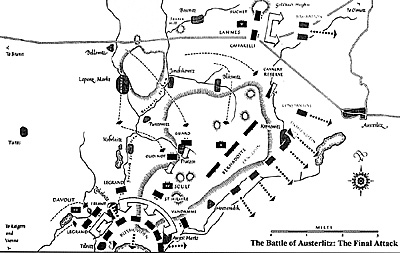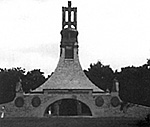The Battle of Austerlitz
2 December 1805
The Battle
text and photos by John Salmon, UK
| |
Early on the morning of the 2nd a heavy mist covered the battlefield, a factor that was already knocking the Allied schedule off balance. After some confusion on the Pratzen as columns of men crashed into one another the Allies made their attacks against Zokolnitz and Telnitz, after a bloody assault the villages were occupied. By approximately 8.30 am Buxhöwden was ready to call forth Kollowrath's columns for their sweeping thrust through the French flank. Prompted by his youthful and inexperienced Emperor, Kutusov released more men into the log jam that was fast developing on the Allied southern flank. These troops pushed forward and crossed to the French side of the Goldbach stream only to be attacked by part of Davout's hard marching corps coming up from Vienna. Davout's intervention managed to prop up Napoleon's shaky southern flank. Away to the north at his command post on the Zurlan Napoleon watched through the clearing mists as the Russian troops march off the Pratzen Heights. But the Emperor's strategy was working, the Allies had denuded their centre on the Pratzen, it was into this void that Napoleon now ordered Soult to advance with the divisions of Vandamme and St. Hilaire. This thrust caught the Allies completely off guard and the French troops marched onto the Heights. Kutusov desperately tried to reinforce his centre but Napoleon countered this by moving Bernodotte's corps down to the village of Bläswitz. Southeast of the Santon Hill Lannes corps was fighting off an attack by Bagration. To their south Murat's cavalry charged forward to fight with the Allied cavalry under Prince Lichtenstein, effectively pinning another of the enemy's striking forces. The Allies though increased the pressure on the French southern flank which Napoleon had to reinforce with Oudinot's Grenadiers. Around 10:30 a.m. Kutusov counter attacked Soult's men on the Pratzen, the French almost broke and it was only by the use of his artillery that Soult managed to hold his positions. Later at 1:00 p.m. the Russian Imperial Guard launched another ferocious attack from the direction of Austerlitz. Soult's tired troops gave ground and briefly surrendered the hill's summit. Bessiers and Rapp with the Guard cavalry charged forward and, reinforced by a division sent by Bernadotte on his own initiative, managed to drive off the Russians and recapture the Heights. Napoleon now moved onto the Pratzen with the Imperial Guard. He had to decide upon his next move. The Allied centre was effectively breached, but it had been a harder task than Napoleon had envisaged. Originally he had intended to swing to the north and crush Bagration but that general had kept his men in good order. Instead Napoleon extemporised and moved south the trap the even bigger prize of Buxhöwden's by now almost shattered columns. Their situation was desperate. Cut off from the main Allied force, attacked by Soult's corps and the French Imperial Guard Buxhöwden's' men were also being bombarded by cannon from the Pratzen Heights. Only one avenue of retreat presented itself and that was across the frozen Satschan Mere. As the men tried to move across the slippery surfaces of the Mere French cannon balls smashed into the ice sending men, horses and cannon crashing through the ice. The retreat turned into a rout. To the north Bagration extracted his men and retreated towards Olmütz. The battle ended at approximately 4:00pm. The butcher's bill was high, the French lost 1,300 killed, 6490 wounded and 500 missing. Allied losses were higher, 16,000 killed and wounded and around 11,000 prisoners as well as 180 cannon and 45 colours. The moral of the Allied commanders had be broken, Emperor Frances of Austria, left the field and would soon be sending emissaries to Napoleon asking for terms. Emperor Alexander of Russia also left the field, his first experience of Napoleonic warfare had been a salutary one, but he lived to fight on other days. As for Kutusov, he escaped and was sent to fight the Turks in obscurity, he would be recalled in 1812 and would grievously wound the French at Borodino on 7 September 1812. His final revenge would come on 27/28 November 1812 when he saw Napoleon's army floundering in its death throws amongst the ice flows of the Beresina River. The Battle Appraised
At right, monument at the top of the Pratzen Heights. Built in 1912, it contains bones from the battlefield and in its own way is an impressive memorial to the men who died there. In subsequent years no Marshall received a title linked to this battle, Napoleon reserved as much of the glory as possible to himself. A monument was raised in Paris made of cannon captured from the Austrians and Russians. French widows and orphans of soldiers who fell in this battle received special pensions, as did the wounded. His bulletins, never totally reliable sources, gilded this particular lily to degree never before seen. Even if we reserve judgement on the Napoleonic hype that the Emperor spun around the battle it must be acknowledge that Napoleon's performance in this battle was indeed brilliant. He used guile to trick the Austrian and Russian allies into false moves over ground that he had specially reconnoitred and prepared for them. When they fell into his trap he ruthlessly exploited their over extension and chopped them up piecemeal. Whilst praising the Emperor we must not ignore the magnificent performance of the Grand Armeé. They had marched long distances, suffered intense cold and privations, but fought like lions. Their commanders had used initiative and skill, the training they had received in the camps at Boulogne had paid large dividends. Napoleon might well say in praise that he was content with them. But was Austerlitz the decisive battle depicted in the histories? What did it achieve? The immediate consequence was that the following day the Austrian Emperor Frances asked Napoleon for an interview. On 4 December an armistice is agreed between France and Austria who also withdrew from the third coalition which collapsed. Napoleon and the French army had escaped from what was a dangerous strategic situation, on any scale this was indeed an impressive result. However the main support of the wars against Napoleon and France, Great Britain, could not be attacked directly, the British naval victory at Trafalgar on 21 October 1805 had seen to that. Britain would remain implacably opposed to the Napoleonic hegemony in Europe and would support a fourth, fifth, sixth and seventh coalitions against the Emperor. The Prussian's, who you may remember were almost on the point of declaring war on the French, held their hand after Austerlitz. They would pay dearly for this in the next year in the Jena/Auerstadt (14 October 1806) debacle. The Russians meanwhile retreated back towards Poland to lick their wounds, although they had suffered great losses they would be back for more when they came to support Prussia in late 1806. It would take the drawn and bloody battle in the frozen snow's of Eylau, 7/8 February 1807, and the pounding of Friedland, 14 June 1807, to bring them to the peace table at Tilsit in July 1807. This would also mark the end of the fourth coalition. As for the Austrians, in just over three years time, supported by subsidies from Great Britain, they would feel strong enough to attack Napoleon again, this time under their best commander the Archduke Charles. The Austrian timing was very opportune, Napoleon's ambition had entangled is empire in the morass of the Spanish ulcer that would bleed the empire of troops and resources for years to come. However despite early successes and the defeat of Napoleon at Aspern-Essling on 21/22 May 1809, the Austrians were eventually defeated after the slogging match of Wargram on 5/6 July. This battle resulted in the armistice of Znaim 10/11 July 1809 which effectively ended the campaign and the fifth coalition against him. Despite these blows, or perhaps because of them the three major mainland powers, Austria, Russia and Prussia nurtured their injured pride and national sentiments. Napoleons over weaning arrogance would drive him to disaster in Russia in 1812. In 1813 first Prussia then Austria would rise, join the sixth coalition and attack Napoleon again, leading to victory in the mammoth battle of Leipzig 16-19 October 1813. The result of which would be retreat for Napoleon to the borders of France which were eventually breached in early 1814. Napoleon abdicated, for the first time on 6 April 1814. His return in 1815 brought fourth a seventh coalition against him. This time Napoleon was defeated in the truly decisive battle of Waterloo, 18 June 1815. Waterloo ended almost 25 years of war and although none of the European powers realised or wanted it a new age of Nation States had arrived. Map of the Battle AreaOnce again I am indebted to David Chandler's invaluable Dictionary of the Napoleonic Wars, published by Greenhill Books, 1993, for the map and copious amounts of background information.  BibliographyDavid Chandler, Dictionary of the Napoleonic Wars, Greenhill Books, 1993.
AcknowledgementsMany thanks to Alan Rooney of Midas Battlefield Tours for a most interesting and enjoyable trip to the Czech Republic in 1997. To see the Battlefiled at very close range and have the action explained by an expert was everything and more that I could have hoped for. Finally and always, many thanks to my wife Elizabeth who has to proof read this and many other efforts, her patience is never ending. Footnotes1 Unless otherwise stated all figures on troops strengths and casualties are taken from David Chandler's, Dictionary of the Napoleonic Wars, Greenhill Books, 1993, pages 31 to 36, for corps strengths see the battle map of the morning situation. 2 David Chandler, Austerlitz 1805, Osprey Publishing Ltd, 1990, p 91. Next issue more photos from Austerlitz More Austerlitz
Austerlitz: The Battle Austerlitz: Jumbo Map (slow: 152K) Austerlitz: Jumbo Photos (extremely slow: 695K) Back to Table of Contents -- First Empire #50 Back to First Empire List of Issues Back to MagWeb Master Magazine List © Copyright 2000 by First Empire. This article appears in MagWeb (Magazine Web) on the Internet World Wide Web. Other military history articles and gaming articles are available at http://www.magweb.com |

 If any battle can be said to be the Emperor's masterpiece this is it. Certainly Napoleon thought so, he jealously guarded the image of the battle that he had drawn in the French public's mind.
If any battle can be said to be the Emperor's masterpiece this is it. Certainly Napoleon thought so, he jealously guarded the image of the battle that he had drawn in the French public's mind.